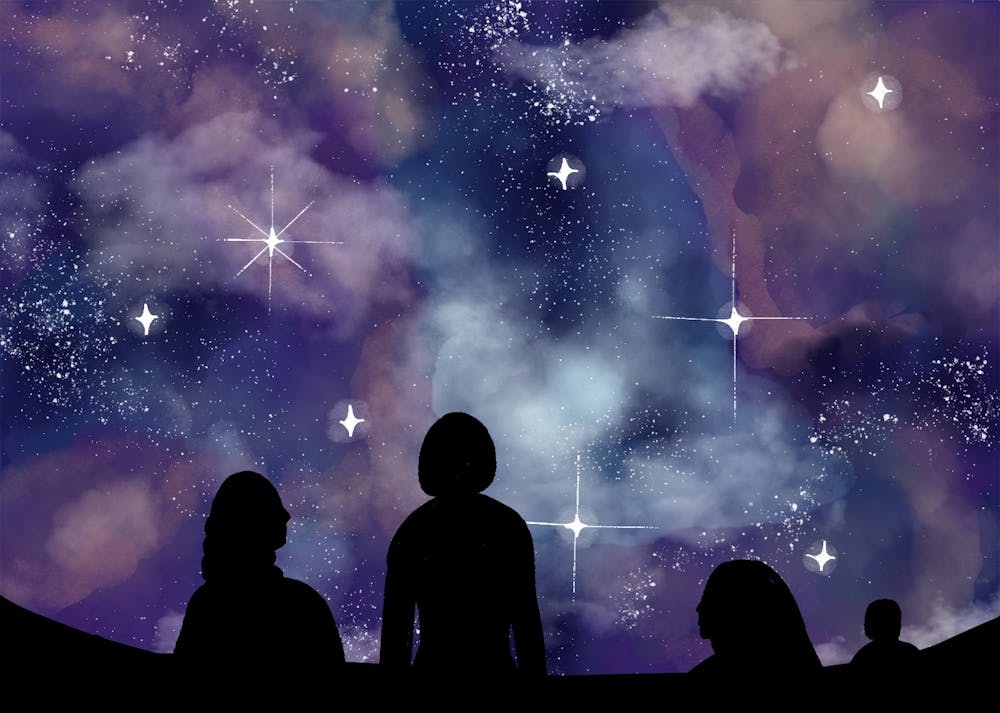"Can you believe Galileo discovered the Galilean Moons?" said Ric Alling, while talking through a live, 3D demonstration of simulated space called "The Edge of Exploration" on Wednesday.
Alling is the manager of the Marston Theater at the School of Earth and Space Exploration, and a fan of cosmic humor. "I know, there's only four astronomy jokes, and I'm gonna run out of them," he said.
Curated by the School of Earth and Space Exploration, The Edge of Exploration is a series of four planned shows during the month of April and May at the Marston Exploration Theater, located inside the Interdisciplinary Science and Technology Building IV.
The demonstration consists of venturing into an hour-long segment of extraterrestrial exploration, each of which is a uniquely manipulated 3D demonstration of live outer space.
Operated through DigitalSky 2, a software that uses astronomical data to create simulations, the demonstration features planets, asteroids, orbit paths, galaxies and stars across the known universe through real-time visual projections.
The software can also shift perspective between multiple points in space, such as the earth's surface, a crater on the moon, or even the moon Europa as seen from Jupiter.
Armaan Dhalla, a senior studying earth and space exploration, controls the program behind the audience.
"Armaan and I, we communicate during the show to create the journey we take the audience through (over) the hour," Alling said.
During the pandemic, Dhalla hosted SESE's "Virtual Night Skies": a star-gazing and astronomy simulation gathering through Zoom. Now back in person, the program morphed into live, ticketed demonstrations for the public.
The transition; however, wasn't easy; though the Marston Theater had been used for playback media presentations, a live demonstration was a novel idea, and the infrastructure required overhaul.
"We had to install new projectors and bring in special 3D-glasses for the show to work," Dhalla said.
The exploration series features battery-operated 3D glasses with high resolution and a switch system to modulate between non-3D elements such as rover and satellite-captured images.
"At last night's show, we had 71 people in the audience, which was a lot more than what we'd originally anticipated," Meg Hufford, a senior coordinator of the outreach program at SESE, said. "It suddenly felt like normal."
The outreach program employs a cultural and artistic perspective, using both physical and digital media to educate about astronomy and spaceflight.
Lindy-Elkins Tanton, ASU foundation and regents professor and principal investigator of the Psyche Misson and Peter Mitchell Rubin, a Los Angeles-based artist, collaborated to create an artistic digital rendering of the asteroid 16 Psyche that is seen in the demonstration.
READ MORE: NASA Psyche Mission set to launch in 2023 with new flight plan
The four segments of The Edge of Exploration series are all different. According to Alling, they individually cover different aspects of space.
"Exploring Time and Distance" which premiered on April 1, features a demonstration of size and scale of the universe. "The Solar System," which premiered on April 12, is a journey through the facets of our solar system, displaying recurring planetary events such as planetary orbit alignments that are simulated by forwarding in time.
"Our Galactic Neighborhood," scheduled for April 15, will voyage into neighboring galaxies and stars outside our solar system. "The Nature of Light," scheduled for May 13, seeks to explain how our understanding and interpretation of light helps navigate the universe.
In addition to DigitalSky 2 simulations, the demonstrations also feature satellite and rover imagery. "The Solar System" features pictures of Mars' surface taken by Mastcam-Z — the ASU-built and designed imaging system aboard the Perseverance Rover currently on Mars.
The pictures are always changing and updated. "We want to keep these things current," Alling said. "Pictures (from the rover) are received and processed in this very building, and we concurrently display them."
The Edge of Exploration series is scheduled through May, with tickets available for demonstrations of all four parts of the series. According to the outreach program, the series is expected to continue through the summer.
Though the "journey" of each show is unique, they all end with a segment that Alling says is the most enthusiastically received: Dhalla propels the audience back to earth from their location light years away from the solar system.
On April 26, ISTB4 will host Student Night with doors opening at 6:15 p.m. The event is meant to bring together students in various clubs and organizations to tour the models inside the building, and get updates from the James Webb Space Telescope. The night will also feature "Exploring Time and Distance" once again at the Marston Theater at 7 p.m.
"We're so glad we can continue doing this in person," Alling said. "It's gonna need a lot more space jokes."
Tickets to the series across its multiple dates and demonstrations are available to the public. For Student Night, tickets will be discounted to $5 for students at the door.
Correction: A previous version of this story misspelled Ric Alling's name. The story was updated on Sunday, April 16, 2023, at 11:57 a.m. to correct the error.
Edited by River Graziano, Jasmine Kabiri and Caera Learmonth.
Reach the reporter at ssswamin@asu.edu and follow @shriiiitt on Twitter.
Like The State Press on Facebook and follow @statepress on Twitter.




